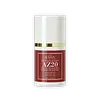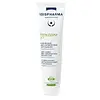What's inside
What's inside
 Key Ingredients
Key Ingredients

 Benefits
Benefits

 Concerns
Concerns

No concerns
 Ingredients Side-by-side
Ingredients Side-by-side

Water
Skin ConditioningAzelaic Acid
BufferingPropylene Glycol
HumectantSodium Hydroxide
BufferingCaprylic/Capric Triglyceride
Masking1,2-Hexanediol
Skin ConditioningCetearyl Alcohol
EmollientGlyceryl Stearate
EmollientDimethicone
EmollientCetearyl Olivate
Sorbitan Olivate
EmulsifyingBetaine
HumectantDimethyl Sulfone
SolventPanthenol
Skin ConditioningAllantoin
Skin ConditioningDipotassium Glycyrrhizate
HumectantCentella Asiatica Extract
CleansingMadecassoside
AntioxidantSodium Hyaluronate
HumectantHydrolyzed Hyaluronic Acid
HumectantTocopherol
AntioxidantCeramide NP
Skin ConditioningPolysorbate 60
EmulsifyingCamellia Sinensis Leaf Extract
AntimicrobialSambucus Nigra Flower Extract
RefreshingMomordica Charantia Fruit Extract
Skin ConditioningLeontopodium Alpinum Extract
Skin ConditioningWater, Azelaic Acid, Propylene Glycol, Sodium Hydroxide, Caprylic/Capric Triglyceride, 1,2-Hexanediol, Cetearyl Alcohol, Glyceryl Stearate, Dimethicone, Cetearyl Olivate, Sorbitan Olivate, Betaine, Dimethyl Sulfone, Panthenol, Allantoin, Dipotassium Glycyrrhizate, Centella Asiatica Extract, Madecassoside, Sodium Hyaluronate, Hydrolyzed Hyaluronic Acid, Tocopherol, Ceramide NP, Polysorbate 60, Camellia Sinensis Leaf Extract, Sambucus Nigra Flower Extract, Momordica Charantia Fruit Extract, Leontopodium Alpinum Extract
Water
Skin ConditioningAzelaic Acid
BufferingCaprylic/Capric Triglyceride
MaskingPentylene Glycol
Skin ConditioningButyl Avocadate
Skin ConditioningGlycerin
HumectantDipropylene Glycol
HumectantHydroxyethyl Acrylate/Sodium Acryloyldimethyl Taurate Copolymer
Emulsion StabilisingXylitylglucoside
HumectantLauryl Glucoside
CleansingPolyglyceryl-2 Dipolyhydroxystearate
Skin ConditioningAnhydroxylitol
HumectantXylitol
HumectantEthylhexylglycerin
Skin ConditioningSclerotium Gum
Emulsion StabilisingChlorphenesin
AntimicrobialBoswellia Serrata Extract
Skin ConditioningO-Cymen-5-Ol
AntimicrobialPolysorbate 60
EmulsifyingSorbitan Isostearate
EmulsifyingSodium Hydroxide
BufferingCitric Acid
BufferingTocopherol
AntioxidantWater, Azelaic Acid, Caprylic/Capric Triglyceride, Pentylene Glycol, Butyl Avocadate, Glycerin, Dipropylene Glycol, Hydroxyethyl Acrylate/Sodium Acryloyldimethyl Taurate Copolymer, Xylitylglucoside, Lauryl Glucoside, Polyglyceryl-2 Dipolyhydroxystearate, Anhydroxylitol, Xylitol, Ethylhexylglycerin, Sclerotium Gum, Chlorphenesin, Boswellia Serrata Extract, O-Cymen-5-Ol, Polysorbate 60, Sorbitan Isostearate, Sodium Hydroxide, Citric Acid, Tocopherol
 Reviews
Reviews

Ingredients Explained
These ingredients are found in both products.
Ingredients higher up in an ingredient list are typically present in a larger amount.
Azelaic acid is a multitasker ingredient that helps treat acne, pigmentation, and irritation. It is a great option for sensitive skin.
What makes azelaic special?
The best thing about azelaic acid is it's gentleness. It's generally well-tolerated and safe to use alongside other actives like niacinamide or salicylic acid.
Unlike AHAs, azelaic acid will not make you photosensitive/sun sensitive.
You can find this ingredient naturally occurring in grains like wheat, rye, and barley. In cosmetics, azelaic acid is typically lab-made, which is more stable and effective.
Learn more about Azelaic AcidThis ingredient is an emollient, solvent, and texture enhancer. It is considered a skin-softener by helping the skin prevent moisture loss.
It helps thicken a product's formula and makes it easier to spread by dissolving clumping compounds.
Caprylic Triglyceride is made by combining glycerin with coconut oil, forming a clear liquid.
While there is an assumption Caprylic Triglyceride can clog pores due to it being derived from coconut oil, there is no research supporting this.
Learn more about Caprylic/Capric TriglyceridePolysorbate 60 is used to help stabilize products. It is a surfactant and emulsifier. These properties help keep ingredients together in a product. Surfactants help reduce surface tension between ingredients with different states, such as liquids and solids. Emulsifiers help prevent oils and waters from separating.
Polysorbate 60 is sorbitol-based and created from the ethoxylation of sorbitan. Ethoxylation is a chemical reaction used to add ethylene oxide. Sorbitan is a the dehydrated version of sorbitol, a sugar found in fruits.
In this case, the 60 comes from reacting 60 units of ethylene oxide with sorbitan.
Polysorbates are commonly used in medicine and foods.
Learn more about Polysorbate 60Sodium Hydroxide is also known as lye or caustic soda. It is used to adjust the pH of products; many ingredients require a specific pH to be effective.
In small amounts, sodium hydroxide is considered safe to use. However, large amounts may cause chemical burns due to its high alkaline.
Your skin has a natural pH and acid mantle. This acid mantle helps prevent harmful bacteria from breaking through. The acid mantle also helps keep your skin hydrated.
"Alkaline" refers to a high pH level. A low pH level would be considered acidic.
Learn more about Sodium HydroxideTocopherol (also known as Vitamin E) is a common antioxidant used to help protect the skin from free-radicals and strengthen the skin barrier. It's also fat soluble - this means our skin is great at absorbing it.
Vitamin E also helps keep your natural skin lipids healthy. Your lipid skin barrier naturally consists of lipids, ceramides, and fatty acids. Vitamin E offers extra protection for your skin’s lipid barrier, keeping your skin healthy and nourished.
Another benefit is a bit of UV protection. Vitamin E helps reduce the damage caused by UVB rays. (It should not replace your sunscreen). Combining it with Vitamin C can decrease sunburned cells and hyperpigmentation after UV exposure.
You might have noticed Vitamin E + C often paired together. This is because it is great at stabilizing Vitamin C. Using the two together helps increase the effectiveness of both ingredients.
There are often claims that Vitamin E can reduce/prevent scarring, but these claims haven't been confirmed by scientific research.
Learn more about TocopherolWater. It's the most common cosmetic ingredient of all. You'll usually see it at the top of ingredient lists, meaning that it makes up the largest part of the product.
So why is it so popular? Water most often acts as a solvent - this means that it helps dissolve other ingredients into the formulation.
You'll also recognize water as that liquid we all need to stay alive. If you see this, drink a glass of water. Stay hydrated!
Learn more about Water